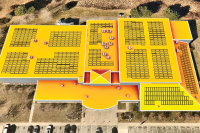Elk population on the rise
The elk herd in Cataloochee Valley added at least eight babies to its ranks this summer, giving the herd a needed population boost.
Since the elk herd was released in the Great Smoky Mountains National Park five years ago, black bears have become adept at scooping up the infant elk in the early weeks after their birth. The number of elk calves who survived each year were just enough to replace adult elk who died, keeping the herd’s numbers around a constant 50.
This year, however, the park captured several black bears that live in the Cataloochee Valley area and relocated them to another part of the park during calving season starting in late May. Black bears have a tendency to return to their home territory after being relocated, so park rangers say they hope many of the bears will make their way back to Cataloochee.
The temporary hiatus, however, will give the elk calves a chance to get on their feet — literally — according to Kim Delozier, wildlife biologist with the Smokies.
When elk calves are born, their mothers leave them in the grass or leaves during the day while they go out and get the nourishment they need to nurse. The baby elk are helpless without their mothers around. Their only defense is camouflage.
But the elk, who were released in the park, were new to bears. As a result, they initially weren’t very good at hiding their calves.
Related Items
The female elk soon learned to start hiding their calves better. The bears learned, too, however. They watched the elk and noted that the mothers eventually returned to their calves’ hiding place to nurse. The calf would leap up to greet its mother, and the bear would rush in.
The female elk were again shocked by this turn of events but soon learned to start chasing off the bears. Nonetheless, only a few elk calves were surviving each year. Coyotes were also preying on the baby elk.
This year, the park decided to give the elk a reprieve by the relocation program. Of 10 known calves that were born, eight have survived.
“This year we are looking at least 80 percent survival,” Delozier said. That’s compared to only a 25 percent survival rate last year.
“It’s night and day,” Delozier said.
The baby elk — mostly born in June — are growing more capable by the day but aren’t totally out of the vulnerable zone.
“We’re over the peak of the hump, but I wouldn’t say we are all the way off the hump,” Delozier said.
Delozier put to rest any fears that Cataloochee’s bear population has been sacrificed for the elk.
“The important thing is that history has shown the bears that have been relocated move back to the capture site,” Delozier said. “It is just a temporary vacation so to speak.”
Elk were once native to the Southern Appalachians until hunted to extinction in the region in the late 1800s. Elk herds were released in the park with the hope of restoring elk as a species in the region.
Delozier said the role of black bears in keeping the elk population in check is a good thing. Before the elk release, biologists considered whether the elk could potentially over-populate the area and become a nuisance. It now appears that won’t be a concern.
“We have to have some kind of biological control, but until we reach that threshold, we have to give them a little help,” Delozier said.
Of the 10 known calves that were born, nine were born in Cataloochee and one in Oconoluftee, an area of the park outside Cherokee that has some large low-lying fields similar to Cataloochee.
Delozier said it seems Oconoluftee is becoming home to a satellite herd.









